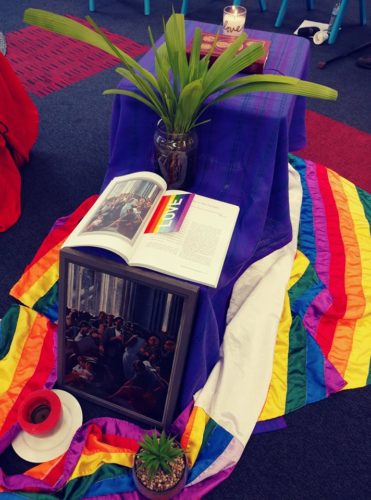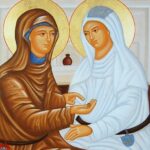Last Updated on April 14, 2025 by Kittredge Cherry

“He poured out the coins of the money-changers and overturned their tables.” — John 2:13 (RSV)
An angry modern-day Christ figure disrupts business in “Jesus Drives Out the Money Changers” from from “The Passion of Christ: A Gay Vision,” a series of 24 paintings by Douglas Blanchard. Jesus, hair flying, overturns tables stacked with money. Coins scatter, bills flutter away, and the men in suits run. A crowd in the background yanks off the barred gate that separates them from the wealthy money managers. One security guard struggles to keep out the mob. Another officer reaches to grab Jesus by the shoulder. Jesus looks like a freedom fighter standing up against greed and income inequality. The setting appears to be a present-day church office or financial institution with statues, classic columns, and a hanging lamp.
This is the same painting that ignited an Internet firestorm after Vatican consultant James Martin shared it in 2019. Breitbart News and other major right-wing extremist media responded with an attack. Far-right Catholic website LifeSiteNews accused Martin, Cherry and Blanchard of creating and promoting “blasphemous homoerotic works depicting the life of Jesus as if he were a gay man” and condemned the LGBTQ movement as “the most grave satanic threat to the Church today.” Then Breitbart News, the voice of the alt-right with 4 million readers, escalated the drama with an article headlined, “LGBT Jesuit Priest Showcases ‘Gay Jesus’ Art.” In the tweet that set off the backlash, Martin included the image “Jesus Drives Out the Money Changers” from “The Passion of Christ: A Gay Vision” with this advice: “Be zealous in the defense of others, especially the poor and marginalized, and all those who are defenseless.” For more info, see the Q Spirit article “Famed Jesuit priest James Martin tweets gay Jesus art — and upsets alt-right media.”
 When Jesus expelled the money changers from the Temple, he was causing “good trouble” — a phrase used by US congressman John Lewis in the context of the movement for racial justice. Black gay activist Bayard Rustin said that every community needs “angelic troublemakers.” These striking phrases wake people up by bringing together opposites. Jesus acted up in a way similar to the confrontational grassroots political group ACT-UP (AIDS Coalition to Unleash Power). It was formed at the Lesbian and Gay Community Services Center in New York City in 1987. Robert Shore-Goss wrote the now-classic book “Jesus Acted Up: A Gay and Lesbian Manifesto” during the AIDS crisis of the early 1990s. He argued that Jesus was a radical activist who advocated anti-establishment principles and therefore churches should welcome LGBTQ people.
When Jesus expelled the money changers from the Temple, he was causing “good trouble” — a phrase used by US congressman John Lewis in the context of the movement for racial justice. Black gay activist Bayard Rustin said that every community needs “angelic troublemakers.” These striking phrases wake people up by bringing together opposites. Jesus acted up in a way similar to the confrontational grassroots political group ACT-UP (AIDS Coalition to Unleash Power). It was formed at the Lesbian and Gay Community Services Center in New York City in 1987. Robert Shore-Goss wrote the now-classic book “Jesus Acted Up: A Gay and Lesbian Manifesto” during the AIDS crisis of the early 1990s. He argued that Jesus was a radical activist who advocated anti-establishment principles and therefore churches should welcome LGBTQ people.
All four gospels describe what is commonly called “the cleansing of the temple.” By some accounts Jesus kicked the money changers out of the Temple as soon as he arrived in Jerusalem. When he saw them taking advantage of people’s faith in God, he exploded. It was the only time that Jesus used physical violence in the Bible. Jesus poured out the coins of the money changers and turned over their tables. Then he made a whip of cords and used it to chase them out, along with the sacrificial animals that they were selling. Nothing made Jesus angrier than religious hypocrisy. He yelled, “My house shall be called a house of prayer, but you make it a den of robbers.” It was one of many occasions when he blasted religious leaders for exploiting the poor. He talked more about money than anything else except God.
Blanchard is right to paint this scene in a place that could be a bank or a church because the Temple in Jerusalem was not only a religious institution, but also functioned like a national bank. The Temple held private deposits of wealth in its treasury, made loans, and collected debts as well as selling animals for sacrifice. The money changers of first-century Jerusalem exchanged foreign currency for the temple coins that were required for paying the annual temple tax and making offerings. They made big profits by using unfair exchange rates and adding service charges. Priests also got a cut.
Jesus’ angry outburst has fascinated artists since the Middle Ages. Their paintings of the episode go by various names, such as the purification of the temple, the expulsion of the money changers, or driving the merchants from the temple. Renaissance master El Greco painted at least five versions. But overall the angry Jesus has been downplayed in favor of the other events from the life of Christ. Modern artists mostly ignore the subject. Blanchard is perhaps the only artist to paint a “gay vision” of the day that Jesus fought back against the merchants who turned the holy temple into a marketplace.
Perhaps other LGBT versions of Jesus expelling the money-changers come not from art, but from action. The protest looks like a scene from Occupy Wall Street, although it was painted a decade before that movement began. Blanchard’s Jesus could be angry about the growing gap between the wealthy one percent and the other 99 percent, or about fundraising tactics that demonize LGBT people, or about countless other forms of economic injustice.
___
Related links:
Slacktivist blogger Fred Clark reflects on his favorite painting from Blanchard’s Passion: “Jesus Drives Out the Money Changers
To read this article in Russian, go to:
Второе очищение Храма: ЛГБТ-перспектива (nuntiare.org)

“The chief priests…feared him, because all the multitude was astonished at his teaching.” — Mark 11:18 (RSV)
A popular teacher distracts church-goers from a worship service in “Jesus Preaches in the Temple.” Jesus, looking like an urban hipster, welcomes the people who crowd around and touch him. The title states that Jesus is preaching, but he stands quietly among them, mouth closed, communicating compassion with his presence. Blue tones conjure a peaceful mood, but there is tension between the upstart preacher and the religious establishment, between the individual and the institution.
This painting raises the question: What would happen if Jesus walked into a church of today? The general consensus is that he would disrupt the established order. Not many Christians would stay meekly in their pews and settle for stale sermons and wafers if they had the chance to see, hear, and touch the living Christ. Those who gain power by speaking for Jesus might prefer to keep him away.
The individualized faces and gestures of Jesus’ listeners invite speculation about their lives. Two gay couples wrap Jesus in a loving embrace: a white couple on the left and a black couple on the right. Jesus puts his arm around one of the blacks while shaking hands with — and perhaps healing — the bald man in the wheelchair. Even the cool guys are drawn to Jesus: one with a spiky mohawk and another smoking a cigarette. Others sit in front, just wanting to be near Jesus: A mother and daughter on the left, and on the right a downcast figure in red high heels. Her tall, awkward body suggests a drag queen or a transwoman.
Large pillars and arches hint that they are in the aisle of a modern cathedral. Far in the distance on the left, a row of priests carries candles or shiny processional crosses, as happens in a contemporary cathedral during worship. But many congregants are more interested in Jesus. A man peeks around the pillar on the back right to see who is causing all the excitement.
Not everyone is pleased to see the charismatic newcomer. Two bald men eavesdrop, arms crossed. Their suits suggest that they are businessmen, but they could easily be church bureaucrats. They look like the money changers who were attacked by Jesus in the previous painting. This pair might even be another gay couple, but a conservative and perhaps closeted duo with a stake in the status quo. Whatever their identity, they are the modern counterparts of the elders, scribes, lawyers, priests and Pharisees in the Bible who observed Jesus in the temple, looking for a way to destroy him.
It’s possible to guess what Jesus might be saying in this painting by reading the lengthy Biblical accounts of his preaching. The two-fold message that the Biblical Jesus taught was love and justice. Blanchard’s “Jesus Preaches in the Temple” balances the previous image of Jesus driving out the moneychangers. He stood for justice against the money changers before, and here he stands for love. The Bible records much of what Jesus taught, but he himself said the most important lesson was this: Love God with all your heart, and love your neighbor as yourself.
One subject that Jesus never discussed directly was homosexuality. He certainly didn’t condemn it in the Bible. He may even have implied that LGBT people are born that way when he said, “There are eunuchs who have been so from birth.” (Matthew 19:12) Some progressive Bible scholars believe that Jesus used an ancient term for LGBT people when he talked about eunuchs. The term translated as “eunuch” probably included not just castrated men, but also a variety of sexual minorities that today would be called LGBT or queer.
Images of Jesus or teaching in the temple are relatively rare in art history. Even Renaissance master Albrecht Durer, whose Small Passion contains no less than 38 engravings, did not include such a scene. The drama of Jesus’ crucifixion tends to overshadow the content of his teachings, but Blanchard reminds viewers that Christ illumined the world not just by the way he died, but by how he lived and what he taught.

The Passion book — and the original painting “Jesus Preaches in the Temple” — were featured on the altar at “LGBTIQ and Catholic: Gifts for Life,” a retreat near Sydney, Australia on June 1, 2019.
___
Next: Day 3: Jesus has a Last Supper, prays alone and is arrested
or see the whole series “The Passion of Christ: A Gay Vision.”
The Passion series features 24 paintings by Douglas Blanchard, with text by Kittredge Cherry. It is also available as a book and prints.
Donate now to the 2025 Palm Sunday/Holy Week offering to support this series.
More resources:
“Jesus Preaches in the Temple” by Chris Glaser: a reflection on Blanchard’s painting with the same title
To read this article in Italian, go to:
Gesù scaccia i cambiavalute e predica nel Tempio. La passione di un Cristo queer (gionata.org)
To read this article in Russian, go to:
Иисус учит в Храме: ЛГБТ-перспектива (nuntiare.org)
___
Top image credit:
3. Jesus Drives Out the Money Changers (from The Passion of Christ: A Gay Vision) by Douglas Blanchard
___
This article was originally published on Q Spirit in April 2017, expanded with new material over time, and was most recently updated on April 14, 2025.
Scripture quotations are from Revised Standard Version of the Bible, copyright © 1946, 1952, and 1971 National Council of the Churches of Christ in the United States of America. Used by permission. All rights reserved.
Copyright © Kittredge Cherry. All rights reserved.
Qspirit.net presents the Jesus in Love Blog on LGBTQ spirituality.



















Trackbacks/Pingbacks